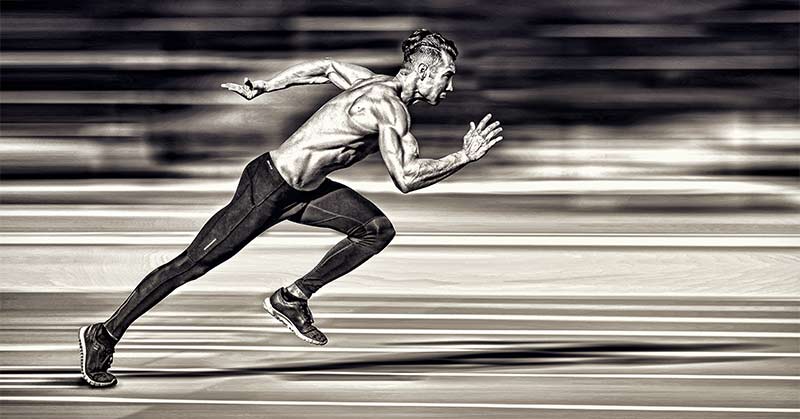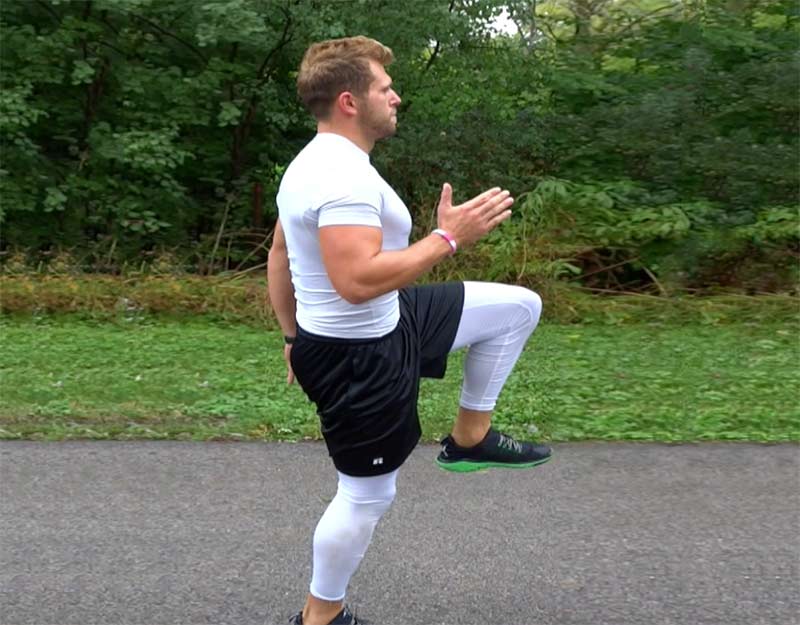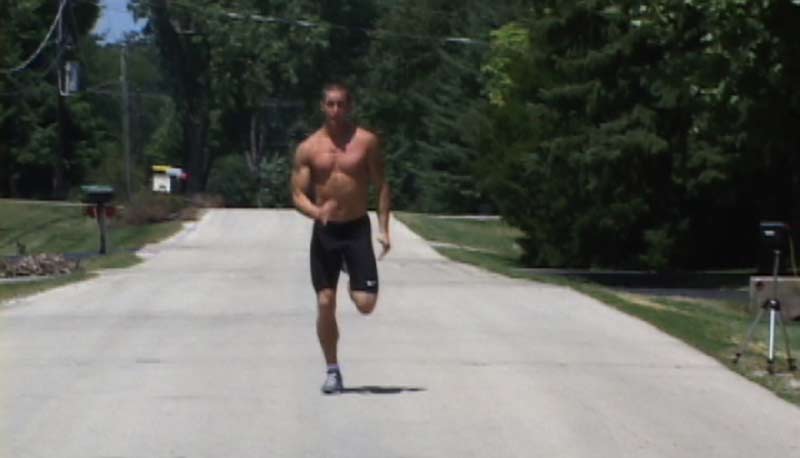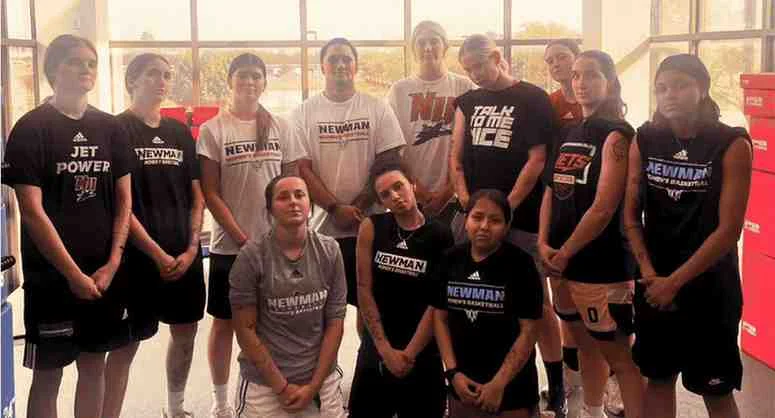
During my years of coaching, I’ve had athletes who became very good at the drills I gave them, but they didn’t improve their form or speed. At times, my athletes have gotten so good at the drills, they were no longer challenged, and they stagnated. I wasn’t challenging their systems. The drills in this article address important points of movement and show how to progress your athletes to make their bodies organize.
My Learning Progression
There is nothing like the spectacle of a track meet. The tension of 100m and 4x100m races gets everyone up in the stands before the gun goes off. The bell laps in distance races when everyone waits to see who has been hanging back and make the fatal mistake of making a move too early. The final jumps or throws in the field events when the crowd claps in unison to motivate the athlete for a bigger performance. And who can forget the drama of a final 4×400 when the meet is on the line.
Even before the meet, there are memorable images. My favorite is when all the pole vaulters are lined up in a big meet, waiting for their run-through. It reminds me of a jousting tournament with all of the knights lined up, waiting their turn.
Equally enjoyable is watching the variety of warm-up drills different teams use: watching runners go through their A skips in perfect unison, runners lying face down doing scorpions, or up against the fence with their hip mobility drills. I wonder how and why coaches pick their warm-up drills.
I, too, bought the speed dynamics video and used it for years. It was fairly easy to implement and, if others were doing it, I believed I should too. I saw Loren Seagrave twice in packed halls, and everyone was sold. He changed the culture of the warm-up.
Questioning the Purpose of Specific Drills
But then I hit a few hurdles. I questioned what I was doing when I had athletes who could do the drills very well, almost as good as the video, but weren’t improving their form or speed. Also, we were getting so good at the drills that they were no longer challenging. It almost became something we did just “because.”
I had athletes that could do the drills very well but weren’t improving their form or speed. Share on XThen, I started to question the purpose of the drills. A perfect example is B skips. I know people love them, but I don’t think there is much pawing of the ground. To change things up, we went to a warm-up with a variety of stiff legged runs (Payton’s or Prime-times, depending on what part of the country you live in). They worked great early in the season but again, we stagnated.
Then, I found some things that really helped my athletes move along. The first was the implementation of Reflexive Performance Reset (RPR). Athletes use a particular recruitment pattern to move their body. Most of the time, athletes are in a neurological survival mode, which means they’re using smaller muscles to do the work. As they strengthen these patterns, their bodies default to these movement patterns.
For example, when an athlete sprints, he’ll initiate hip flexion with his psoas muscle and extend with this glute max. But when an athlete goes through his strength tests, these muscles fail. By performing RPR wake-up drills, an athlete can get his prime movers, or performance muscles, to become the initiators of the movement pattern. From a coaches’ perspective, they run differently. From an athlete’s perspective, they feel lighter and faster.
Frans Bosch
Also, I figured out Frans Bosch. I bought the DVD, Running: The BK Method, watched it quickly, and discarded its contents onto a pile of other DVDs. But for some reason, I was brought back to the DVD. And it clicked. So, I bought the book, Running. I think my copy has more of my pencil markings than the ink used to print the book. I started an email correspondence with Frans to learn more. I started to implement his drills in our practices and saw the impact on how my athletes moved. A big impact, in fact. We ran very fast. Some of the fastest times in the history of the state with kids that had no business being on that stage based on their looks.
But again, I hit another hurdle. We got really good at doing the drills about four weeks into the season, and then we stagnated. We were doing the drills just to do the drills. We weren’t challenging our systems.
Bosch then released Strength Training and Coordination: An Integrative Approach which offers insight into challenging the motor learning system. The basic drills are the elements of running—quick foot off the ground followed by a hip drive with strong lateral support. The result is toe off position with the knee under the glute and the swing knee out in front for a positive running position.
Drills for Progression
As we get better at specific movements, we need to challenge the body to find the point where the body self-organizes when challenged and where the body is allowed to get out of a limited self-protection mode. If we change the environment or pattern, we teach the system to reorganize and strengthen the patterns we want to strengthen. (Trying to explanation this would be a whole article in itself). The book explains this concept throughout multiple chapters. For a nice quick summary, check out bettermovement.com.
I use some basic movement patterns that we drill. I don’t like calling it a warm-up. Too many athletes think a warm-up is a social time when things are done just to get the blood moving. These drills become worthless once that attitude surfaces. I sometimes change when we do the drills in practice to challenge the “state of the body” or challenge the body when fatigued. The drills address important points of movement and show how we progress to make the body organize.
High Knee Action
We call these booms.
Purpose: To train the high knee action with support from the opposite hip. At least that’s how it looks. It’s actually a movement that trains the scissoring motion of the legs and teaches the “foot from above” principle. It also teaches a high hip posture of the stance leg. Once we’re strong in this position, we learn to scissor the leg in a fast action.

Progressions: Stress the movement while other actions occur, always challenging the movement to be as clean as possible. It becomes the go-to position. Key points are tall posture and reaching for the ground, and knees passing as high up as possible to simulate positive running.
- Week 1: Boom, just a switch of the leg, workout (WO) 2 hands overhead, WO 3 hands push or press, WO 4 halos.
- Week 2: Boom-Boom, same progression
- Week 3: Boom-Boom-Boom, same progression
- Week 4: High knees, same progression
- Week 5: High knees onto 1- to 2-inch mats with the same progression
- Week 6: High knees with a stop every 3rd or 4th step, same upper progression
- Week 7: High knees mixing week 5 and 6, same upper progression
- Week 8: High knees with a twist, rotate 45 degrees every 4 to 5 steps, same upper progression
- Week 9: High knees with 10lb bar on back
- Week 10: Up to 8-inch box with a stop, same arm progression as week 1
- Week 11: Stairs
- Week 12: Stairs with a stop
- Week 13: Stairs with light bar on back
Hip Hike or High Hip Action
Purpose: To teach a better position for the hips. Ideally, when an athlete is on one leg at midstance phase, the hip of the stance leg should hold the leg in place directly underneath the hip socket, and the outside of the foot should line up with the outside of the body. The hip of the swing leg hip should be slightly higher than the hip of the stance leg.
- Week 1: Spiderman crawls, lateral crawls
- Week 2: Step downs
- Week 3: Weighted step downs
- Week 4: Weighted step downs, wall touches with bounce
- Week 5: High knees with a bounce, lateral high knees with bounce
- Week 6: Weight overhead high knees with a bounce, lateral high knees with bounce
- Week 7: Weight overhead, skips over hurdle
- Week 8: Skips over hurdle, WO 2 overhead
- Week 9: Skips for power (speed and distance)
- Week 10: Skips power and speed with bar on back (no rotation)
- Week 11: Skips power w/twist
- Week 12: Skips power, halo
Ankle Foot Action
Progression: Works on the stiffness of the ankle. The key is to keep the ankles as stiff as possible.
- Week 1-2: Legged toe pops
- Week 2: 2-legged toe pops with weight
- Week 3: 2-legged pops onto mats/boxes (6-8 inches)
- Week 4: Alternating toe pops
- Week 5: Single leg pops
- Week 6: Single leg pops with mat on side, double leg up a hill
- Week 7: Single leg pops with box on side, alternating up a hill
- Week 8: Single leg up a hill, double skip prime time
- Week 9: Single up a hill distance, double skip prime time overhead
- Week 10: Double leg hurdle jumps small to big, single leg pops on box
- Week 11: Small box over hurdle over hurdle, single leg hops over hurdle
- Week 12: Hurdle bounce box bounce hurdle, single leg hops over hurdles
- Week 13: Consecutive big hurdles

A coach can adjust the drills at any time. While the goal is to constantly challenge the body to learn better movement, if the athletes are stuck, there is nothing wrong with repeating a week of work or slowing things down. To get a better picture of what the drills look like, I have some rough videos of the progressions for sale through my websites, Slow Speed Guy and videos here. Thanks for the support.
For those who missed the Track and Football Consortium 4, we have the entire Consortium filmed. We have great topics for download. Here is the link for the Consortium, including my hour presentation on the subject of this article that further explains the exercises.




